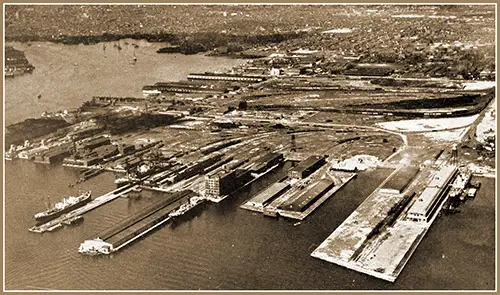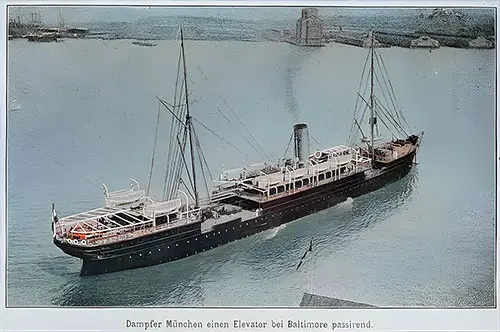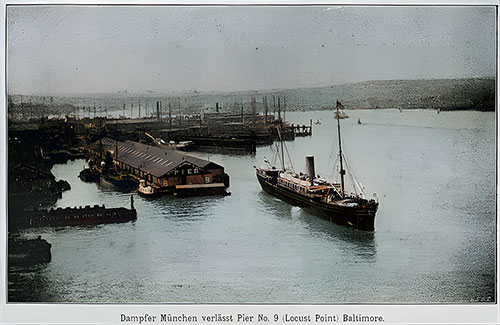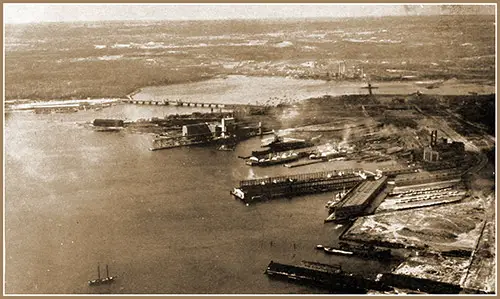Baltimore Passenger Lists 1881-1938

View of the Canton Company Terminal and Baltimore Harbor, 1940. Port and Terminal Facilities at the Port of Baltimore, MD, 1941. | GGA Image ID # 1d46a14776
Baltimore is located in the central area of Maryland along the tidal portion of the Patapsco River, an arm of the Chesapeake Bay. Founded in 1729, Baltimore is the second largest seaport in the Mid-Atlantic United States and is situated closer to Midwestern markets than any other major seaport on the East Coast. Baltimore's Inner Harbor was once the second leading port of entry for immigrants to the United States and a major manufacturing center.
Passenger Lists (PLs) available from the GG Archives Calling at the Port of Baltimore, Maryland, USA.
1900s
North German Lloyd / Norddeutscher Lloyd
1930s
Baltimore Mail Line
- 1932-01-29 SS City of Hamburg - Hamburg to Norfolk and Baltimore
- 1932-06-24 SS City Of Hamburg - Hamburg to Norfolk and Baltimore
- 1934-03-17 SS City of Hamburg - Hamburg to Norfolk and Baltimore
- 1934-11-24 SS City of Hamburg - Bremen to Norfolk and Baltimore
- 1935-01-12 SS City Of Newport News - Hamburg to Norfolk and Baltimore
- 1936-07-11 SS City of Norfolk - Hamburg to Norfolk and Baltimore
- 1937-07-24 SS City Of Baltimore - Hamburg to Norfolk and Baltimore
- 1937-08-15 SS City of Norfolk - Bremen to Norfolk and Baltimore
- 1938-04-11 SS City of Newport News - Bremen to Norfolk and Baltimore
Note: Typically, only the origination and final destination ports are listed in each link. Other intermediary ports of call are not listed.

SS München Passes an Elevator Near Baltimore circa 1892. (Norddeutscher Lloyd Geschichte und Handbuch, 1892) | GGA Image ID # 2283876e4f

Steamer München leaves Pier No. 9 (Locust Point) Baltimore circa 1892. (Norddeutscher Lloyd Geschichte und Handbuch, 1892) | GGA Image ID # 2283b0511a
The Port of Baltimore (1923)
Despite prevailing national economic and trade difficulties, the Port of Baltimore is actively sustaining its terminal position. Under the inspiration of the available $50,000.000 loan for harbor development and the latest official government cargo-tonnage statistical statement, the port has steadily progressed in all phases of shipping and export, giving Baltimore third ranking among the United States ocean terminals' import activities.
Before the war, the port's most significant strides were made in overseas and intercoastal shipping services. Baltimore's trans-oceanic vessel lines numbered only 12, serving 15 foreign ports, while there are currently available for the carriage of general merchandise 43 regular lines operating 55 services to over 100 foreign terminals.
These promise approximately 36 sailings per month to United Kingdom ports, 10 per month to Scandinavian ports, 10 to West Indian ports, 9 to French ports, 8 to German ports, 6 to Dutch ports, 5 to Belgian ports, and adequate service to the Mediterranean districts, and the Far and Near East.
Such a record effectively disposes of the contention that New York alone of the Atlantic ports furnishes satisfactory frequency of overseas vessel service.
Baltimore's coastwise and inter-coastal services have steadily increased in the past three years. Previous to that, Baltimore had practically no vessels operating to or from the Pacific coast. In contrast, there are 11 lines in active service via the Panama Canal, giving almost daily sailing over a distance of 5,500 miles.
Government figures for the first six months indicate that Baltimore leads all Atlantic and Gulf ports in westbound tonnage movement over this route. The coastwise service of the port also gives efficient and frequent service to all ports on the Atlantic, with 10 lines in active operation.

Western Maryland Railway, Port Covington Terminal. With Coal Pier and Grain Elevator in Background. McComas Street Pier at Center. Port and Terminal Facilities at the Port of Baltimore, MD, 1941. | GGA Image ID # 1d46a30210
In handling all types of cargo, the port possesses unequaled facilities. The largest and best-equipped pier for coal handling in the world is owned by the Baltimore & Ohio railroad and situated at Curtis Bay in the local harbor. This facility has several unique loading records. Canton Elevator No. 3 of the Pennsylvania Railroad is the largest plant of its kind. It has established unsurpassed grain records for speed in loading ships.
In this connection, mention should also be made of the excellent coal pier, the large grain elevator of the Western Maryland Railway, and the proposed elevator terminal development of the Baltimore & Ohio Railroad to replace the grain facilities of that road destroyed recently by fire, all located within the harbor. This latter plant, with loading galleries extending over the merchandise piers, will be completed in 1924.
Specializing in handling hulk ore and Sulphur cargoes is the modern plant of the Cottman Company. These facilities having two large cranes and an advanced car loader, also hold Atlantic coast records for vessel discharging and box-car loading.
In addition to these facilities for handling basic cargoes and the variety of overseas and intercoastal steamship services, Baltimore possesses many other advantages to attract the inland shipper and vessel operator.
Included among these are unusually low port charges; absence of dockage assessments and wharfage charges on export and import freight brought to or taken from the port by rail or by rail and water; free delivery to any point in the harbor of all shipments which pay a small minimum rail charge; advantageous port geographical location, which makes possible a lower inland freight rate than to New York, Boston or Philadelphia; temperate climate; insignificant tidal range; and adequate foreign banking facilities for financing overseas consignments.
Storage space at the port is abundant. Elaborate pier accommodations assure prompt berthage; extensive shipbuilding and repair facilities and labor conditions are unusually stable.
"The Port of Baltimore," in World Ports, Vol. XII, No. 1, November 1923, pp. 113-115
⚠️ About Accuracy in Historical Records Research Tip
Context. The GG Archives presents passenger lists as faithfully as possible to the original documents. While OCR is generally accurate, portions of these collections—especially image captions and some transcriptions—are typed by hand and may include typographical or spelling variations. The original manifests themselves also contained clerical inconsistencies (names recorded phonetically, mid-voyage corrections, etc.).
What this means for your research:
- Search variant spellings of names (e.g., “Schmidt/Schmitt/Smith,” “Giuseppe/Joseph”).
- Cross-reference with immigration cards, passport applications, naturalization files, city directories, and newspapers.
- Treat manifests as primary sources with historical quirks—use them alongside corroborating records.
- For place names, consider historical borders and language variants (e.g., Danzig/Gdańsk, Trieste/Trst).
How to cite. When quoting a name from a manifest, consider adding [sic] for obvious misspellings and include a note such as “spelling as printed in original passenger list.”
Need help? If you spot a likely transcription error in captions, feel free to contact us with the page URL and a brief note—we love community input. 🙏
Curator’s Note
For over 25 years, I've been dedicated to a unique mission: tracking down, curating, preserving, scanning, and transcribing historical materials. These materials, carefully researched, organized, and enriched with context, live on here at the GG Archives. Each passenger list isn't just posted — it's a testament to our commitment to helping you see the people and stories behind the names.
It hasn't always been easy. In the early years, I wasn't sure the site would survive, and I often paid the hosting bills out of my own pocket. But I never built this site for the money — I built it because I love history and believe it's worth preserving. It's a labor of love that I've dedicated myself to, and I'm committed to keeping it going.
If you've found something here that helped your research, sparked a family story, or just made you smile, I'd love to hear about it. Your experiences and stories are the real reward for me. And if you'd like to help keep this labor of love going, there's a "Contribute to the Website" link tucked away on our About page.
📜 History is worth keeping. Thanks for visiting and keeping it alive with me.
